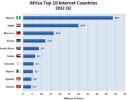The 2019 African Economic Outlook by the African Development Bank (AfDB) suggests five trade policy actions that can bring Africa’s total gains to 4.5% of its GDP, or $134 billion a year.
The report launched on Friday in Addis Ababa, Ethiopia on the sidelines of the African Union Summit suggested the following policies to improve Africa’s trade performance.
First is eliminating all of today’s applied bilateral tariffs in Africa. Second is keeping rules of origin simple, flexible, and transparent. Third is removing all non-tariff barriers on goods and services trade on a most-favored-nation basis.
Fourth is implementing the World Trade Organization’s Trade Facilitation Agreement to reduce the time it takes to cross borders and the transaction costs tied to non-tariff measures.
Fifth is negotiating with other developing countries to reduce by half their tariffs and non-tariff barriers on a most-favored-nation basis.
The 2019 Outlook also looks at the gains possible from regional public goods, such as synchronizing financial governance frameworks, pooling power, opening skies to competition, and opening borders to free movements of people, goods, and services.
This year’s African Economic Outlook shows that the continent’s general economic performance continues to improve. Gross domestic product reached an estimated 3.5 percent in 2018, about the same as in 2017 and up from 2.1 percent in 2016. Africa’s GDP growth is projected to accelerate to 4.0 percent in 2019 and 4.1 percent in 2020.
But even that growth is not fast enough to address persistent fiscal and current account deficits and unsustainable debt. Indeed, countries have to move to a higher growth path and increase the efficiency of growth in generating decent jobs. The 2019 Outlook shows that macroeconomic and employment outcomes are better when industry leads growth.
The special theme this year is regional integration for Africa’s economic prosperity—integration not just for trade and economic cooperation but also for the delivery of regional public goods.
In its last part, the report provides short-to-medium term forecasts on the evolution of key macroeconomic indicators for all 54 regional member countries, as well as analysis on the state of socio-economic challenges and progress made in each country. This adds granularity to the more aggregated analysis conducted in the first part of the report.

